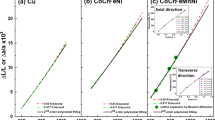Abstract
A method for calculating the parameters of formation of vacancies in crystals formed by spherically symmetrical atoms was developed. Both quantum effects at low temperatures and the possibility of the delocalization of atoms at high temperatures were studied. The parameters of formation of vacancies in carbon subgroup element crystals C-diam, Si, Ge, α-Sn, and Pb were calculated. The inclusion of the delocalization of atoms was shown to increase the enthalpy, entropy, and volume of vacancy formation. At low temperatures, the parameters of vacancy formation were found to depend strongly on the temperature, and the entropy of vacancy formation became negative. At high temperatures, close agreement with experimental data and theoretical estimates reported by other authors was obtained. The temperature dependence of vacancy parameters was studied for diamond heated isobarically from 100 to 4500 K. The applicability scope of the Arrhenius equation with a temperature-independent activation energy is discussed. The validity of the “compensation rule” (correlation between the entropy and enthalpy of vacancy formation) was demonstrated. It was also shown that the volume and entropy of vacancy formation were correlated over the whole temperature range studied.
Similar content being viewed by others
References
S. M. Stishov, Pis’ma Zh. Eksp. Teor. Fiz. 71(1), 25 (2000) [JETP Lett. 71 (1), 15 (2000)].
M. N. Magomedov, Zh. Neorg. Khim. 49(12), 2057 (2004) [Russ. J. Inorg. Chem. 49 (12), 1906 (2004)].
B. F. Ormont, Introduction to Physical Chemistry and Crystal Chemistry of Semiconductors (Vysshaya Shkola, Moscow, 1968) [in Russian].
C. Kittel, Introduction Solid State Physics, 5th ed. (Wiley, New York, 1976; Nauka, Moscow, 1978).
P. A. Varotsos and K. D. Alexopoulos, Thermodynamics of Point Defects and Their Relation with Bulk Properties (North-Nolland, Amsterdam, 1986).
A. N. Orlov and Yu. V. Trushin, Energy of Point Defects in Metals (Energoatomizdat, Moscow, 1983) [in Russian].
L. A. Girifalco, Statistical Physics of Materials (Wiley, New York, 1973; Mir, Moscow, 1975).
Handbook of Mathematical Functions with Formulas, Graphs, and Mathematical Tables, 10th ed., Ed. by M. Abramowitz and I. A. Stegun (U.S. Dept. of Commerce, Washington, 1972; Nauka, Moscow, 1979).
M. N. Magomedov, Teplofiz. Vys. Temp. 27(2), 279 (1989).
M. N. Magomedov, Teplofiz. Vys. Temp. 39(4), 559 (2001) [High Temp. 39 (4), 518 (2001)].
M. N. Magomedov, Metally, No. 6, 27 (2001).
M. N. Magomedov, Rasplavy 17(5), 66 (2003).
R. P. Feynman, Statistical Mechanics: A Set of Lectures (Benjamin, Mass., 1972; Mir, Moscow, 1978).
M. N. Magomedov, Rasplavy 3(2), 67 (1989).
M. N. Magomedov, Rasplavy 6(2), 49 (1992).
M. N. Magomedov, Zh. Fiz. Khim. 67(4), 669 (1993).
S. I. Novikova, Thermal Expansion of Solids (Nauka, Moscow, 1974) [in Russian].
M. N. Magomedov, Metallofizika 13(5), 106 (1991).
I. V. Aleksandrov, A. F. Goncharov, A. N. Zisman, and S. M. Stishov, Zh. Eksp. Teor. Fiz. 93(8), 680 (1987).
M. N. Magomedov, Zh. Fiz. Khim. 76(5), 785 (2002) [Russ. J. Phys. Chem. 76 (5), 687 (2002).
M. N. Magomedov, Zh. Fiz. Khim. 62(8), 2103 (1988).
Shu Zhen and G. J. Davies, Phys. Status Solidi A 78(2), 595 (1983).
V. E. Zinov’ev, Thermal Properteis of Metals at High Temperatures: A Handbook (Metallurgiya, Moscow, 1989) [in Russian].
Physical Properties of Diamond: A Handbook, Ed. by N. V. Novikov (Naukova Dumka, Kiev, 1987) [in Russian].
H. J. McSkimin and P. Andreatch, J. Appl. Phys. 43(7), 2944 (1972).
L. A. Shul’man, Sverkhtverd. Mater., No. 4, 58 (1993).
N. F. Uvarov, E. F. Hairetdinov, and W. Bollmann, Cryst. Res. Technol. 24(5), 543 (1989).
D. Sh. Tsagareishvilli, Methods for Calculating Thermal and Elastic Properties of Crystalline Inorganic Substances (Metsniereba, Tbilisi, 1977) [in Russian].
S. V. Stankus, R. A. Khairulin, and P. V. Tyagel’skii, Teplofiz. Vys. Temp. 37(4), 559 (1999) [High Temp. 37 (4), 529 (1999)].
V. N. Chebotin, Physical Chemistry of Solid State (Khimiya, Moscow, 1982) [in Russian].
U. Krause, J. P. Kuska, and R. Wedell, Phys. Status Solidi B 151(2), 479 (1989).
Y. Taji, J. Phys. Soc. Jpn. 48(4), 1237 (1980).
P. M. Fahey, P. B. Griffin, and J. D. Plummer, Rev. Mod. Phys. 61(2), 289 (1989).
E. T. Turkdogan, Physical Chemistry of High Temperature Technology (Academic, New York, 1980; Metallurgiya, Moscow, 1985) [in Russian].
P. Varotsos and K. Alexopoulos, Phys. Rev. B: Condens. Mater 15(8), 4111 (1977).
K. T. Koga, M. J. Walter, N. Eizo, and K. Katsura, Phys. Revi. B: Condens. Matter 72(2), 024108 (1–4) (2005).
P. Varotsos and K. Alexopoulos, J. Phys. C: Solid State Phys. 12(19), L761 (1979).
I. Iwasa, J. Phys. Soc. Jpn. 56(5), 1635 (1987).
V. A. Kisilishin, Dokl. Akad. Nauk SSSR 295(1), 127 (1987).
P. Mialhe, J. Phys. D: Appl. Phys. 22(5), 720 (1989).
A. Yelon and B. Movaghar, Phys. Rev. Lett. 65(5), 618 (1990).
M. N. Magomedov, Teplofiz. Vys. Temp. 40(1), 152 (2002) [High Temp. 40 (1), 142 (2002)].
M. N. Magomedov, Zh. Fiz. Khim. 76(1), 139 (2002) [Russ. J. Phys. Chem. 76 (1), 123 (2002)].
M. N. Magomedov, Pis’ma Zh. Tekh. Fiz. 28(10), 64 (2002) [Tech. Phys. Lett. 28 (5), 430 (2002)].
Author information
Authors and Affiliations
Rights and permissions
About this article
Cite this article
Magomedov, M.N. The thermodynamic characteristics of formation of vacancies in carbon subgroup element crystals. Russ. J. Phys. Chem. 80 (Suppl 1), S140–S151 (2006). https://doi.org/10.1134/S0036024406130243
Received:
Issue Date:
DOI: https://doi.org/10.1134/S0036024406130243




